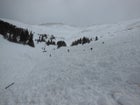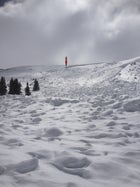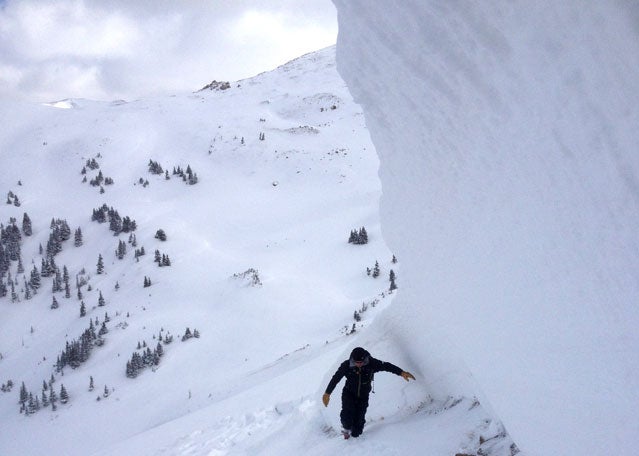Jerome Boulay opened his eyes to darkness: He’d been buried alive. He remembers his surprise as he was able to move his left hand across his face, clearing an airway to the surface. Buried, but alive.
Tunnel Vision
What started as a glorious powder day ended in a desperate fight for survival after three skiers were buried by a killer avalanche in the backcountry of Stevens Pass, in Washington’s Cascades.


“I was gasping for air and thought for sure I was dying, with snow packed so tightly around my throat that I couldn’t breathe,” he’d later tell one of his rescuers.
“I could think only of my daughters. I was just freaking out.”
As he began the slow process of digging himself out, one brush of his fingertips at a time, he came to a harder truth: The five guys he’d been with just seconds before were gone.
He’d have four hours of hell, revisiting the day’s mistakes and missteps as he lay prone in the snow in Sheep’s Creek, less than 200 yards from US Route 6 on Colorado’s Loveland Pass, where the group had parked just moments before triggering a slab avalanche. Unable to free his arm enough to dig the rest of himself out—much less rescue his five friends, two of them buried within inches of him—it was all he could do to shout into the wind for the next several hours in the hopes somebody would hear him.
Joe Timlin—sales manager for Jones Snowboards, Yes Snowboards, and Now Bindings—the man who’d organized the weekend’s Rocky Mountain High Backcountry Gathering as a backcountry safety and splitboard gear demo: Gone. His truck was parked less than 200 yards from where he was buried.
Rick Gaukel, the certified avalanche-safety instructor who’d given a briefing on the dangerous snow conditions earlier that morning: Gone. Rescuers would later find his body tangled up in Boulay’s legs.
According to the official report from Brian Lazar, deputy director of the (CAIC), the three men had evidently skinned across a perceived danger zone to make it to a stand of trees they’d deemed an “island of safety,” waiting for three others in the group to cross.
But the avalanche didn’t heed their safe zone. It broke above them as their collective weight pulled down on a layer of heavy snow. Lazar’s crew of investigators measured the massive slide as . Heavy spring storms had dumped 41 inches in the previous week. Below where rescuers found Boulay and the bodies of Gaukel and Timlin, they’d eventually find three more bodies buried under at least 12 feet of debris.
Also in the group was skier Ian Lanphere, co-founder of Gecko Climbing Skins, whose gold-standard product was being used by nearly everyone in the group that day; and Chis Peters, Timlin’s best friend and an experienced snowboarder, who came to support the backcountry safety demo; and Ryan Novack, a Crested Butte-based photographer and longtime friend of Boulay’s.
The final tally of five fatalities gave the Sheep’s Creek slide the dreadful distinction of the deadliest avalanche in Colorado since 1962. The gargantuan slide was upon the group so swiftly that none of the men had time to deploy the several airbags between them, or to use the Avalung breathing aids many of them wore.
ON ANY GIVEN SATURDAY you might find dozens upon dozens of skiers and snowboarders on Loveland Pass, home to some of the most accessible backcountry terrain in the country. Plenty of those riders have little to no backcountry training or experience, and plenty of them ride with little to no backcountry equipment. The men who died in Saturday’s slide were not those guys.
The fundraising event that Timilin held at the Dillon Dam Brewery that weekend raised $1,750 for the Friends of the CAIC. Twenty-five to 30 people came out Saturday morning to hear Gaukel advise them on avalanche safety and to demo next season’s splitboarding gear from the event’s sponsors. Gaukel pointed out the dangers of the weak layer in the snowpack that caused slide risk to be deemed “considerable” according to the day’s forecast from the CAIC.
“These weren’t just some yahoos throwing an event,” emphasizes David Carrier Porcheron, Joe Timlin’s brother-in-law and owner of , where Timlin was transitioning to a new position as head engineer. “Joe was definitely aware of the dangers of backcountry snowboarding—he’d made it his life— and everyone in that crew was fully aware of the specific dangers that day. After assessing the risk, they opted to take a shorter hike they thought would be safer.”
Porcheron says he’s attempted to shield Timlin’s wife from readers’ comments on various news stories. “Armchair experts saying these guys were idiots, that they should have known better,” says Porcheron, “But there’s nothing to be learned from that kind of criticism, or from imagining these guys were stupid. The truth is that they were educated, and did a lot of things right, and still got caught in the wrong place at the wrong time.”
Unfortunately, the story of backcountry experts getting caught in the wrong place at the wrong time is not new. And it’s hard to ignore the argument that on some days there is no “safer route,” and the only defensible decision is not to head out into the backcountry.
“They were all experienced people, and they let their guard down,” says Kurt Olesek, co-founder of the Colorado Snowboard Archive collection at the
Olesek, still spooked from the death of his good friend a few days earlier in a slide in Vail Pass’s aptly-named Avalanche Bowl, opted to head out in the opposite direction with a different group for a south-facing slope on the other side of Loveland Valley. “I think there was just too much enthusiasm. They were gonna do a quick lap, thinking, ‘It’s not far; it’s not steep.’ They shouldn’t have crossed that slope to begin with. Rick should have known that better than anyone there, but Joe’s no dummy, Ian’s no dummy. It’s easy to get excited: ‘I’m gonna do a great run—I’m safe since I’m with my bros.’ Then you don’t follow protocol. That’s when shit goes down.”
Olesek says Rick Gaukel’s own advice earlier that morning prompted his group’s decision to head for a south-facing slope. Gaukel had relayed the CAIC’s forecast to the event attendees, warning of the same “deep persistent slab problem” that had killed McCarron on Thursday, April 18.
“Rick gave us a safety briefing in the morning,” Olesek recalls. “He said, ‘The suspect aspects are north-, northeast-, to east-facing slopes. That’s what slid up at Vail Pass; that’s what we need to be cautious of. We’re here to make smart decisions.’”
Forty-five minutes into his hike, Olesek could see the debris from the slide across the valley but didn’t worry about his crew: He couldn’t believe anyone would head in that direction after the morning’s discussion. His group finished their hike, then took a quick run down to meet for beers by their cars, where they learned that six men were unaccounted for.
“We were like, ‘Oh, shit, let’s go, let’s go!’ We jumped into my car and raced up to the hairpin, and sure enough, Joe’s truck was there. But by the time we got out there it was probably close to two and a half hours since we had first noticed the slide. We knew it was just a recovery at that point, and we sat there and heard the [Search and Rescue] calls come over the radio: ‘We found another victim … no pulse … We found another one.'”
SATURDAY’S DEATHS WILL BRING NEW SCRUTINY to the growing community of backcountry enthusiasts, and to the gear industry supporting their off-piste pursuits. And nagging questions surrounding the safety of backcountry skiing resurface: Is backcountry education able to mitigate the level of risk riders take on? Or even more unsettling, is backcountry awareness and the availability of new backcountry equipment fostering a false sense of security?
This winter, ski industry giant K2 bought the backcountry gear manufacturer Backcountry Access, signaling that alpine touring has hit the big time.
According to Kelly Davis, the research director at SnowSports Industries America (SIA), splitboard sales were up 14 percent in the 2012–2013 season, sales of climbing skins were up 12 percent, and Alpine Touring boot sales more than doubled.
“Frankly [backcountry gear] only makes up a few thousand units a season,” says Davis, “But when you look at the percentage growth on splitboards and alpine touring gear in recent years, it’s just tremendous.” The group’s SIA Snow Show trade show in Denver in January responded to the industry’s growth with a Backcountry Experience exhibit and a “Business of the Backcountry” panel that included (Joe Timlin’s boss at Jones Snowboards), CAIC director Ethan Greene, and ESPN.com freeskiing editor Megan Michelson (whose first-person account of last year’s Stevens Pass avalanche, “Tunnel Vision,” was published in ���ϳԹ��� in November 2012).
But SIA’s Backcountry Task Force has found that education hasn’t kept pace with the new technology. “It’s not just about the beacon, the probe, the shovel, the airbags and avalungs,” says Davis, “It’s about decision-making and rescue skills. There’s a very real need to emphasize that the most important piece of gear you take into the backcountry is your brain.”
That was the message Joe Timlin had hoped to promote with his Rocky Mountain High Backcountry Gathering on Loveland Pass, and one his friends and family hope isn’t lost.
“One of the saddest things about Joe’s death is that he had been actively working to address issues of backcountry safety,” Porcheron says. “It was something he and Jeremy Jones had spoken about extensively, and they had been working on plans for a Jones Snowboards tour this fall emphasizing safety and backcountry decision-making, because they felt it was their responsibility as they were marketing splitboards and float packs and all this. It’s so crazy and heartbreaking that this happened on a day when he was putting up an event for the community of shredders in Colorado to be more aware of the avalanche danger.”
says the group on Saturday failed to adapt their behavior to their understanding of the conditions. “With the known risk of a deep hard-slab avalanche like this one, you really have to give yourself a huge margin for error,” he says. “Although this accident was really tragic, it was avoidable.”
Sergeant Rick Safe of the Clear Creek County Sheriff’s Office participated in the recovery effort. “From the looks of it they were being pretty cautious,” Safe says, “But they clearly weren’t expecting this particular position to be anywhere near as dangerous as it ended up being for them.”
All had activated their beacons, but the danger must have seemed so moderate that none of them had exposed the ripcords that would have allowed them to trigger their airbags.


